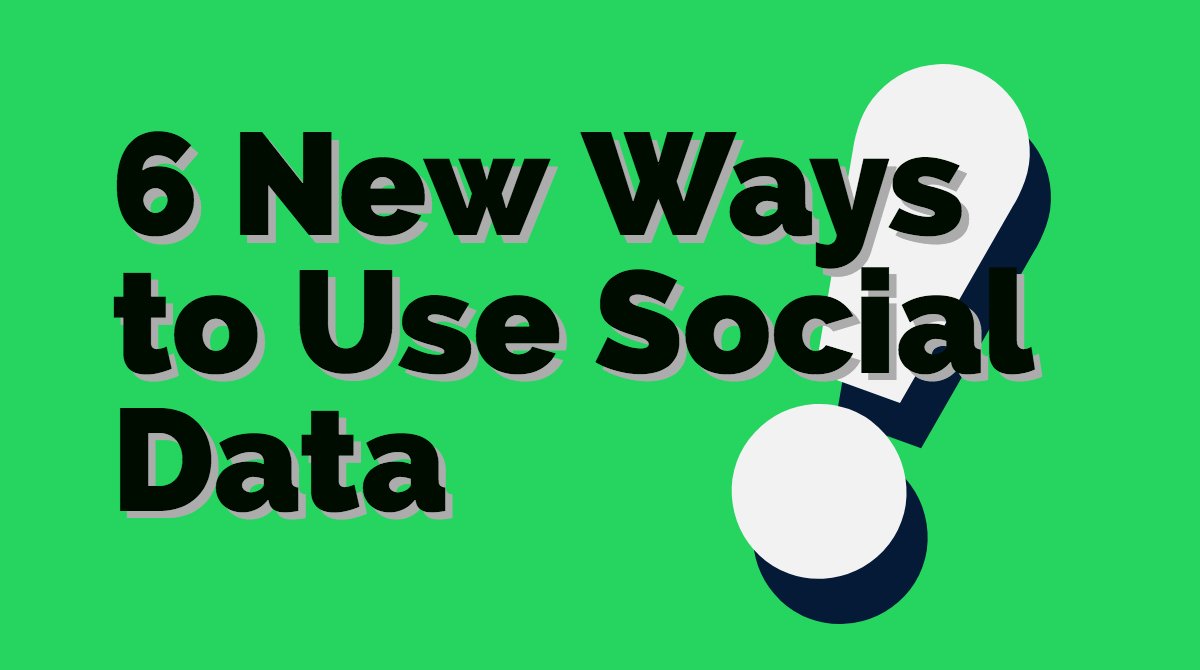
6 New Ways to Use Social Data
Last week, we held our webinar “6 New Ways to Use Social Data (That You Aren’t Already),” featuring myself and Brooke Andersen, Senior Social Strategist here at Simply Measured.
We talked about the limiting beliefs social marketers tend towards, and how to expand your footprint in your marketing organization with social data. Find the recording below. Below that, I’ll walk you through the six ways you should be using social data today.
1. Industry Research
Brooke spoke to this point beautifully, using her experience putting together analysis for major brands on our Professional Services team. Leverage social data to gain a broad view of your industry. Use this data to determine upcoming trends for your brand’s content strategy.
- Trends: Keep an eye on what is coming to modify and strategize content. What are the conversations bubbling up to the surface around your industry (“fitness”) or product offerings (“yoga pants”)? How can you use these in your content and campaigns moving forward?
- Audience: Identify new audience segments to tap into. Is there an audience that you haven’t reached yet, which you can target or create specific content to acquire?
- Product or services opportunities: Find opportunities in customer pain points. Identify the top three pain points, AKA sources of negative sentiment, to learn what consumers dislike within your industry.
But how do you present your findings so they actually have an impact in your organization? We covered that, too.

2. Ads Research
The next creative way you can use social data is for ads research.
Looking at social data, you can identify content copy and media themes for your ads. For instance, if you’re looking to sell a new lipstick, find out the specific context in which consumers discuss lipstick today. Do they treat it as a must-have daily essential, or something they only use on a night out with friends? Or are there two distinctly different audiences/conversations around this?
Knowing how consumers discuss your product category on social media can help your creative team create content that resonates more strongly with consumers.
You can also look at your existing content to determine which content is already engaging to inform your team.
Lastly, look at the top data sources where your audience is discussing this topic. If they’re sharing primarily on Twitter, should all your budget be going to Facebook?

3. Partnership Growth
Use your social data for partnership growth. First, you can use social data to identify new partners. Find out the answers to these questions.

Remember that you want a healthy mix of established partners—partners who have strong, active communities on social—and emerging partners. You can broaden your reach with established brands on social, and leverage the content, energy, and personality of smaller brands in growth mode.
Next up, use social data to expand partnerships you already have.

And, finally, remember that this isn’t a one-way street. You can use social data to convey your value and report to partners on what you’re bringing to the table, and the progress you’re making.

4. Product Development
This next use of social data is a frequent deliverable asked of our Professional Services team. Many companies are beginning to understand the product landscape on social before development and launch.

Before Simply Measured, Brooke led social strategy for Whole Foods in the PNW. Overseeing 19 stores offered many opportunities for her to share the company’s products that are most often requested directly from customers. Brooke would compile the data and share it directly with food buyers to determine future opportunities for product development/features.

5. Next-Level Customer Care
Social media management is a unique role in that it typically lives on the marketing team, but also has to do with customer care. That is its great benefit. Social marketers know their audience’s makeup and behavior better than anyone else in the marketing organization.
But today, too many social marketers take a reactive approach to customer care and crisis management. With social data and building strong protocols, the future is all about proactivity.

Here’s how to present what you find to key stakeholders.
-
- Here’s what happened: Here’s the pain point, here’s the social audience reaction, here’s how we as a brand reacted.
- Here’s the larger context: How you got here and how larger cultural shifts are affecting your brand.
- Here’s the impact: Come up with an impact scale, from 1-10. What does this indicate for your brand, beyond an unhappy customer? Is there something that needs to change in the broader organization?
- Here’s what we’re doing moving forward:How will you make a change moving forward? Put together a new playbook? Tweak a campaign? Invest in analytics software and a more regular analysis cadence? And how will you hold yourself accountable?
6. Testing Your Messages
You can use your social data to test various themes and messages for your upcoming campaigns.

Do this for everything from wording of your message to the type of visuals you are posting to the hashtags you are trying to choose between.
 Need some extra help using social data to boost creativity and efficacy for your own brand? Download the guide below.
Need some extra help using social data to boost creativity and efficacy for your own brand? Download the guide below.





